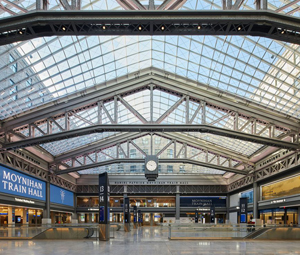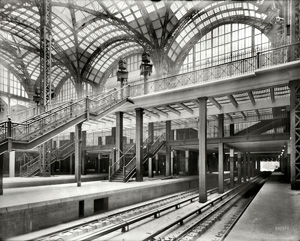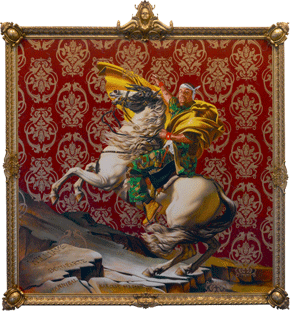Looking Up
John Haberin New York City
Moynihan Train Hall at Penn Station
Elmgreen and Dragset, Kehinde Wiley, and Stan Douglas
In October 1963, the wrecking ball came for Pennsylvania Station—an urban landmark by any standard and the impetus for landmark preservation ever since. It was only the first of many indignities. It was also the start of fifty years of protests on behalf of something better.
Did Joe Biden, as vice president, call LaGuardia a Third World airport? The station's successor would put any nation to shame. And its planners all but cried out in shame, by shoveling it into a basement between Seventh and Eighth Avenues.  An opening on New Year's Day cannot remedy the damage, but it can mitigate it. Moynihan Train Hall is not a replacement, but an addition, serving Amtrak and the Long Island Railroad while leaving riders on New Jersey Transit behind. Still, things are literally looking up.
An opening on New Year's Day cannot remedy the damage, but it can mitigate it. Moynihan Train Hall is not a replacement, but an addition, serving Amtrak and the Long Island Railroad while leaving riders on New Jersey Transit behind. Still, things are literally looking up.
Above the indignities
Who can count the indignities? Demolition took time, while two full city blocks, once the site of five hundred separate buildings, lay in ruins. Visitors to the observation deck of the Empire State Building could look down on their remains. Where the old Penn Station could almost make commuters look forward to work, the new structure shared with Robert Moses, the "master builder" behind it all, an utter disdain for mass transit. Where McKim, Mead & White had found inspiration in European train stations and ancient Rome's Caracalla Baths, the new station had the cheap linoleum look of a 1950s suburban kitchen—the kind that Pop Art and Martha Rosler rode mercilessly. And where the 1910 station had been part of the fabric of the city, it fell to give air rights to Madison Square Garden, where suburban kids could pass through to cheer on Billy Joel and the New York Rangers.
Perhaps the greatest indignity of all was that descent into the basement. The space was cramped enough from day one, its low ceilings and absence of natural light in bitter contrast to the old station's mammoth stone arches and soaring glass and steel. It could only grow more cramped over the years as the city prospered—to the point that the Long Island Railroad has been bringing tracks to Grand Central Station across town, a work still in progress. (Grand Central otherwise serves Metro North, which runs up the Hudson River and east to Connecticut.) To make things worse, Chris Christie as governor of New Jersey killed plans for a second Amtrak tunnel (dubbed the Gateway Tunnel) between his state and Penn Station, to permit repair and to relieve crowding. The feds were going to pay for it, but never mind when, to a Republican, sound government is itself the enemy and the people casualties of war.
As senator from New York, Daniel Patrick Moynihan experienced the indignities many a time on his commute to Washington. He also held out for a solution until his death in 2003. He advocated converting the Farley Post Office across Eighth Avenue into something finer. Long neglected, it looked dark and dismal enough behind its Corinthian columns, in space that served three years of the Spring Break art fair. Yet it could take advantage of the grandeur and sheer size of the building, which served as a mail sorting station, and tracks already extended beneath it. Now his dreams have come true as Moynihan Train Hall, designed by Skidmore, Owings & Merrill.
One enters not up the building's exterior stairs, which lead to an ordinary post office, but to either side. If you enter at Eighth and 33rd, you first encounter the seal of New York and the state's motto in larger letters as well. In case you have forgotten, it is Excelsior: ever upward. You can hardly help looking up at that—to the peaked skylight of the enormous hall, with plenty of sunshine and a view to the south. After more than half a century, glass and steel are back.
You may have come to look up, for that view and a descending clock by Peter Pennoyer. Vertical strips run along its cube, for a touch of art deco or the setbacks of a classic skyscraper. You may have come, too, to look up to art. An imagined city by Michael Elmgreen and Ingar Dragset, based in part on New York architecture, hangs overhead just inside another entrance, on 31st Street between Eighth and Ninth Avenues. Also midblock but off 33rd Street, Kehinde Wiley paints the ceiling. He depicts life in the clouds.
You can also reach them by heading up to a mezzanine, which will eventually have shops. (A food court will settle in back downstairs—assuming that New York after Covid-19 can ever eat indoors again.) For now, it has only a public lounge and the art. Wiley paints on glass interrupted by steel tracery, like the stained glass of a cathedral. It may have you thinking of the skylight, and sure enough from the mezzanine you are at roughly eye level with the clock. You are at eye level as well with an animation of the New York area running the length of central hall.
The first step
The animation is as attention getting as the art, and so is photocollage of the completed Moynihan Train Hall still to come. Another lounge, for ticket holders, has staged recreations of the first Penn Station by Stan Douglas, with a period cast. His wide photographs do not mesh seamlessly, but they have the breadth of a diorama all the same. The lounge itself, by Rockwell Group, has a touch of period charm in walnut benches. Between them and Douglas, one can better appreciate the solid, functional side of the old, lost station,  which in prints can look like glass and steel ruins even when intact. But then Skidmore, Owings & Merrill would like you to know just how much stone was quarried for their train hall.
which in prints can look like glass and steel ruins even when intact. But then Skidmore, Owings & Merrill would like you to know just how much stone was quarried for their train hall.
Not everyone is looking back or looking up. You can add a waiting hall or put lipstick on a pig, but the indignity of Penn Station remains. The addition requires a walk west, well past the Sixth or Seventh Avenue subway and further still from the east side. That might not matter to a senator with a car waiting, but the rest of us may not be so lucky. Why not remake Penn Station with better materials, higher ceilings, a glass enclosure, and cleaner circulation for all? When, for that matter, will work on the Gateway Tunnel begin?
I asked just that in the past, and I shall try not to repeat it all here. I was picking up on objections by the architecture critic of The New York Times, Michael Kimmelman (who has since come out in praise of the new addition), but he is not alone. Others speak cautiously but hopefully of Moynihan Train Hall as a mere first step. They have reservations, too, and not just the kind for seating on a train. The architects, they know, are brilliant but corporate, contributing along with David Childs to the unsightly display of wealth further to the west, in Hudson Yards. Childs can also take credit for One World Trade Center.
The new hall is a delight, unmatched by the atrium of the Stavros Niarchos Foundation Library, but still largely a recreation. It lacks personalized touches apart from the walnut benches. As for the upstairs lounge by FXCollaborative, welcoming as it is, it could come out of pretty much any airport, even LaGuardia. The art plays it safe, too, only starting with period costumes. Kehinde Wiley has become everyone's go-to black artist, in art fairs or one of two Obama state portraits, for his feel-good attitude and straightforward realism. Elmgreen and Dragset can never resist a riff on the monumental or the sky.
Still, Moynihan Train Hall is a huge first step. It makes a renovation of Penn Station easier, now that commuters have somewhere else to go. More than that, the new station is a pleasure, however much a familiar one. It follows the outlines of the Farley Post Office, but that is the point. Indeed, much of the project's public purpose lies in the building's much needed restoration. It cannot compete with the unifying imagination of Grand Central Station, but then what can?
It says something that so large and public a project opened on a holiday, with few commuters and no fanfare. It wants to contribute to the city, not tower above, and it was happy to usher in a new year, not quite a new era. I found myself walking back objections, up to a point, starting with its accessibility. One can enter either the train hall or Penn Station directly from a corridor past the Eighth Avenue subway, which connects the two. It remains to be seen whether Hudson Yards, the High Line (which may eventually extend to the train hall), and their privileged audience will shift New York's center west as well. Will they be enough to bring an expanded station back into the fabric of the city?
A city larger than life
The three works of art embody the new hall's promise and uncertainty. Douglas celebrates the current station by picturing the old one. His scenes have the warmth of old photos as well. One can hardly believe that he made them up, with a skill worth cherishing. But then one can hardly believe either in a view so uncritical. Wall text elsewhere of the station's history can only help, thanks to its poignant reality.
The other two, like the animation, celebrate Moynihan Train Hall by situating it in present-day New York. It just happens to be an imagined New York in the sky. For Elmgreen and Dragset, the city consists entirely of skyscrapers. Try not to mind that the building itself is just two stories high. Their sculpture contains echoes of existing skyscrapers, but only some, and part of the experience of the work is the temptation to pin them down. The packed array of buildings only adds to the sense of fantasy.
Wiley yearns that much more for a city larger than life. In his paintings, young African Americans become not so much individuals or the subject of racism as brand names. He yearns, too, for the cachet of art history. He modeled an equestrian portrait on Jacques-Louis David and his Napoleon crossing the Alps, and his sky-borne bodies in motion inhabit a realm out of Giambattista Tiepolo in the late Baroque. He asks to forget that the new train hall will serve only a small fraction of commuters, even those on Amtrak and the LIRR—and a far smaller fraction of the city's people of color. He can only settle for a higher existence up in the clouds.
Still, both artists bring things down to earth, in search of a more resilient New York City. Those skyscrapers hang in the sky, but upside-down. You might think of yourself with your feet on the ground as flying above them.  Wiley, in turn, finds his cast on an idealized New York street, and they are not flying but dancing. They are also not just male, a departure for him, and they are in good company. The three glass panels take the shape of two circles and a notched oval that evoke painting's and architecture's past.
Wiley, in turn, finds his cast on an idealized New York street, and they are not flying but dancing. They are also not just male, a departure for him, and they are in good company. The three glass panels take the shape of two circles and a notched oval that evoke painting's and architecture's past.
Enjoy them all, and cut them all a break. They have the limits of public commissions, like the station itself, but they serve a public interest. They are secondary to the success and failure of an expanded Penn Station. They offer signs of the future, amid signage for arrivals and departures. On New Year's Day, everything ran on time. No one that day was enforcing too strictly the requirement that only ticket holders can enter the main lounge, so I could see Douglas and his view of the past as well.
After that, who knows—especially after a presumed return to normal after Covid-19. The train hall might serve only 20 percent of the station's passengers, but that may change. It is only that first step, but others may follow. They may not come any time soon, but funding for the Gateway Tunnel is likely to come through during the Biden administration. Now if only the step after that were halfway likely within a lifetime. And if only my walk home that day had not taken me through the basement and Penn Station.

Moynihan Train Hall opened January 1, 2021. A related review looks at hopes for Penn Station itself.




